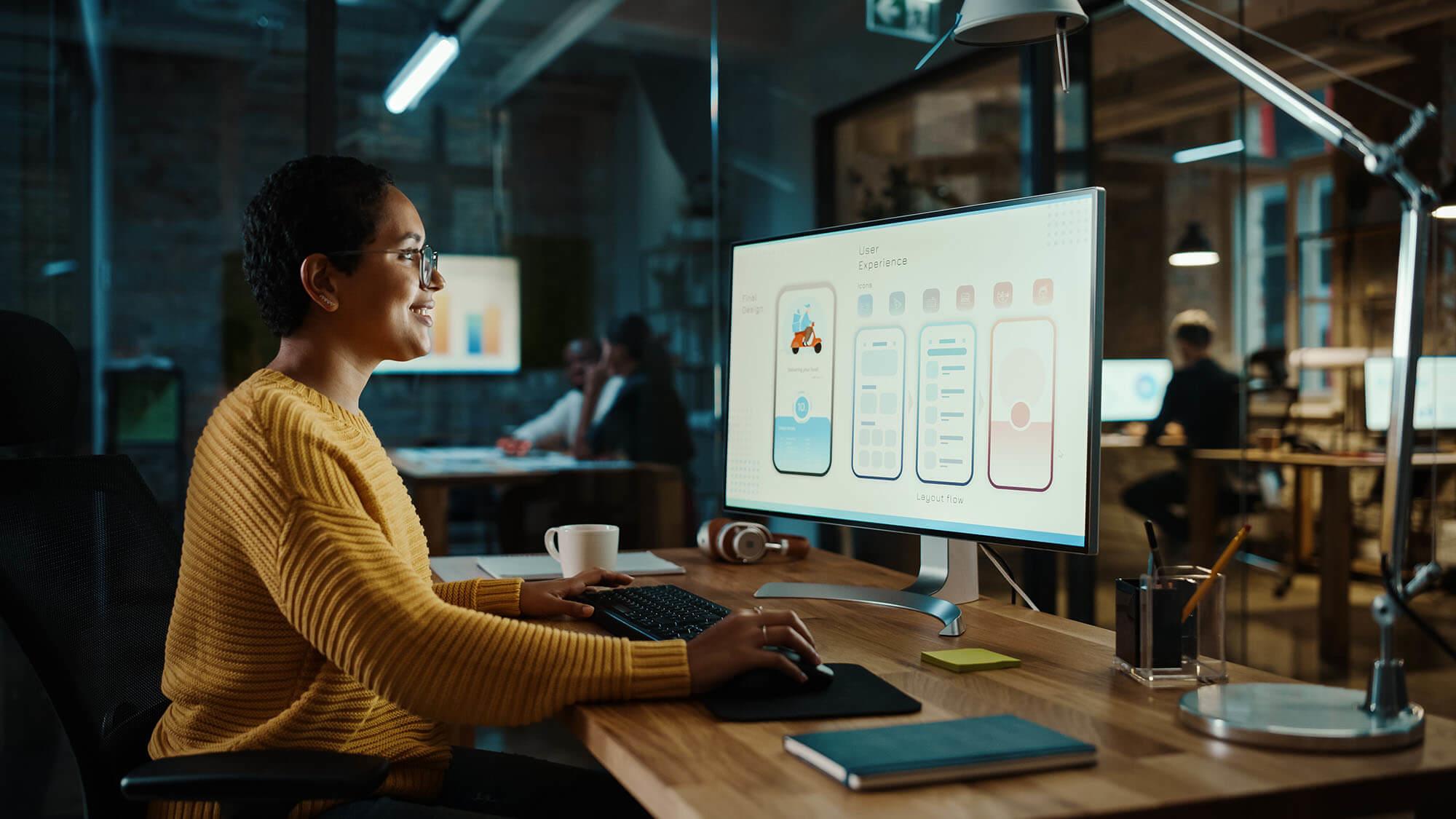Web Design South Africa Predictions: What Will Dominate in the Next 5 Years?
Wiki Article
The Important Components of Efficient Website Design: A Comprehensive Guide
Efficient website design encompasses different critical elements that greatly effect customer experience. It demands mindful factor to consider of variables such as mobile responsiveness, instinctive navigating, and visual power structure. Each component plays a crucial role in crafting an internet site that not just attracts visitors however additionally keeps them. Comprehending these fundamental facets is essential for organizations aiming to enhance their on the internet existence. Yet, what absolutely distinguishes a successful web site from its rivals?Understanding User Experience (UX) Design
User experience (UX) Design acts as the backbone of efficient website design, concentrating on how individuals engage with a web site. It encompasses different elements, consisting of functionality, access, and overall complete satisfaction. A successful UX Design begins with user research, recognizing the target market's requirements and habits. Wireframes and prototypes are after that established to imagine the site's structure and circulation. Web Design Johannesburg. Testing with genuine individuals supplies valuable understandings, permitting designers to boost and fine-tune the interface navigating. Visual Design components, such as typography and color pattern, boost the overall visual while supporting capability. Eventually, effective UX Design warranties that customers can conveniently achieve their objectives, cultivating involvement and loyalty. By focusing on user experience, internet sites can accomplish greater conversion rates and a positive track recordImportance of Mobile Responsiveness
As mobile tools significantly control net use, ensuring mobile responsiveness has actually ended up being crucial for efficient website design. Websites that are not enhanced for mobile can lead to a bad customer experience, resulting in higher bounce rates and shed opportunities. A mobile-responsive Design enables web content to adjust perfectly to different display sizes, making sure that customers can access information conveniently, despite the device they utilize. In addition, online search engine focus on mobile-friendly internet sites in their positions, making responsiveness a critical element for exposure and web traffic. With an expanding variety of customers accessing the net via mobile phones and tablets, organizations must purchase mobile responsiveness to boost customer involvement, boost brand name perception, and inevitably drive conversions. Effective internet Design need to focus on mobile responsiveness to continue to be competitive in today's electronic landscape.Crafting Instinctive Navigating
Navigating functions as the backbone of any type of efficient site, directing site visitors with web content easily. An instinctive navigating framework improves individual experience by allowing users to find information rapidly and efficiently. Clear labeling of food selection things is essential; it should show the material accurately, staying clear of lingo that may confuse individuals. Additionally, a sensible hierarchy is essential, enabling customers to discern relationships in between various sections. Uniformity across web pages helps enhance expectations, while breadcrumbs provide context and a feeling of direction. Receptive navigation food selections that adapt to different tools even more enhance access. Ultimately, the objective is to produce a seamless journey for visitors, ensuring they can explore the website without frustration, leading to a much more engaged and pleased audience.Utilizing Aesthetic Power Structure
Visual power structure plays a critical function in internet Design by guiding customers' interest and boosting their experience. Effective format strategies, together with thoughtful choices in color and typography, can considerably affect how info is perceived and refined. Recognizing these components is important for producing aesthetically appealing and useful sites.Value of Visual Power Structure
Efficient website design rests on the idea of aesthetic power structure, which overviews individuals through content in a user-friendly and logical manner. This concept is crucial for enhancing individual experience, as it aids prioritize information and directs focus to crucial aspects. By developing a clear power structure, internet designers can guarantee that customers easily determine essential messages, contacts us to activity, and navigating choices. A well-structured aesthetic hierarchy reduces cognitive tons, permitting customers to refine info effectively. In addition, it promotes engagement by developing an enticing design that invites expedition. Eventually, comprehending the significance of aesthetic power structure is important for any type of web developer intending to develop effective and straightforward websites that successfully communicate their intended messages.
Techniques for Efficient Design
An efficient format functions as the backbone of any kind of effective internet Design, permitting users to effortlessly browse through material. Efficient techniques consist of grid systems, which give an organized structure for lining up aspects, guaranteeing uniformity and equilibrium. Additionally, making use of whitespace purposefully can improve concentrate on essential locations, decreasing aesthetic clutter and guiding customer interest. Focusing on content with dimension and positioning further highlights essential info, while contrasting aspects can develop a clear visual power structure. Carrying out responsive Design techniques warranties formats adapt effortlessly across devices, preserving usability. Incorporating instinctive navigating aids, such as food selections and buttons, boosts customer experience, making it much easier for site visitors to discover pertinent information promptly. With each other, these techniques develop the structure of an effective web format.Shade and Typography Choices
While shade and typography choices may appear like simple Design aspects, they play a vital role in establishing aesthetic power structure on a web site (Internet Advertising In South Africa). Shade can guide individuals' focus, distinguish areas, and convey brand identity. By tactically making use of contrasting shades, developers can highlight crucial calls to action, guaranteeing they attract attention. Typography, on the various other hand, affects readability and user engagement. A well-chosen font can communicate tone and individuality, while varying font dimensions and weights can create a clear structure. Bigger, bolder headings draw attention, while smaller sized body message gives thorough details. With each other, reliable shade and typography choices develop a natural visual experience, leading users via the web content effortlessly and improving overall usabilityPicking the Right Color Design
Just how does one pick the perfect color scheme for a web site? Selecting the ideal color design is important for enhancing user experience and conveying the brand name's message. Designers must start by considering the target market and the feelings that various colors stimulate. Blue typically symbolizes depend on, while red can create seriousness. It is vital to restrict the palette to a few complementary shades to keep aesthetic consistency and prevent frustrating users. Utilizing devices like shade wheel applications can help in picking colors that function well with each other. Additionally, designers must guarantee that there is enough contrast between text and background colors for readability. Inevitably, a well-thought-out color pattern can considerably influence a website's efficiency and individual engagement.Integrating Engaging Material

Engaging material is important for her comment is here preserving the attention and capturing of website site visitors. It functions as a bridge in between the website's Design and the user's experience, promoting deeper connections. Reliable web content often includes a mix of informative short articles, captivating visuals, and interactive aspects that motivate user involvement. By utilizing storytelling methods, internet sites can evoke emotions, making the material extra unforgettable and relatable. Furthermore, including user-generated web content, such as reviews or testimonies, improves reputation and constructs depend on with the target market. Clear calls-to-action overview individuals towards desired outcomes, guaranteeing they remain engaged. In general, a tactical approach to content development not just enhances user experience yet likewise drives conversions, making it a vital aspect of reliable website design.
Optimizing for Rate and Efficiency
Enhancing for rate and performance is essential for boosting user experience on an internet site. Techniques such as image compression, minifying CSS and JavaScript, and leveraging web browser caching can greatly decrease loading times - Website Design Klerksdorp. These methods not only improve efficiency but likewise add to better internet search engine rankingsImage Compression Techniques

Minifying CSS and JavaScript
Although several web designers concentrate on image optimization, minifying CSS and JavaScript is equally essential for boosting site speed and performance. Minification includes getting rid of unnecessary personalities from code, such as whitespace, comments, and format, without impacting its capability. This process causes smaller documents sizes, which causes faster packing times and improved individual experience. By reducing the quantity of information transferred in between the server and the customer, minification assists decrease data transfer use and boosts total site performance. In addition, internet search engine prefer faster web sites, which can improve search rankings. Applying devices and automated processes for minifying these manuscripts can streamline web advancement and maintenance, making certain that efficiency stays a top priority throughout the lifecycle of a website.Leveraging Web Browser Caching
Leveraging web browser caching considerably boosts internet site rate and efficiency by storing often accessed sources in your area on a customer's tool. This technique decreases the demand for duplicated requests to the server, significantly minimizing packing times for returning visitors. By utilizing HTTP headers, internet programmers can define caching policies for different sources, such as manuscripts, stylesheets, and photos. Effectively implemented caching strategies permit customers to experience faster page loads, causing enhanced individual satisfaction and involvement. In addition, find out online search engine favor websites with maximized performance, possibly improving search rankings. Frequently examining and taking care of cache settings assures that customers get up-to-date web content while still benefiting from the efficiency of cached resources. In conclusion, reliable browser caching is a vital component of enhancing internet performance.Regularly Asked Questions
Just how Do I Choose the Right Website Design Tools?

Selecting the best website design devices involves examining task requirements, comprehending customer demands, and evaluating different software features. Compatibility, simplicity of usage, and area assistance are also necessary factors to think about for efficient Design end results.
What Prevail Website Design Mistakes to Prevent?
Typical internet Design blunders to stay clear of consist of cluttered layouts, bad navigating, insufficient mobile responsiveness, slow-moving filling times, and neglecting user experience. Efficient styles focus on capability, simplicity, and ease of access to involve customers and boost contentment.How Can I Measure My Website's Success?
To determine a website's success, one may analyze metrics such as website traffic, conversion prices, customer interaction, and bounce rates. Using devices like Google Analytics can offer beneficial insights for continuous optimization and improvement strategies.What Duty Does Search Engine Optimization Play in Website Design?
SEO significantly influences web Design by making certain that web sites are structured for internet search engine presence. This includes maximizing website rate, mobile responsiveness, and content quality, ultimately enhancing customer experience and driving organic website traffic.How Frequently Should I Update My Website Design?
The regularity of internet site Design updates depends upon industry patterns, user feedback, and technical improvements. Generally, a refresh every 2-3 years is advisable, making certain the site remains pertinent and lined up with existing standards and customer assumptions.User experience (UX) Design offers as the foundation of reliable web Design, concentrating on just how individuals connect with a site. With an expanding number of users accessing the web via smartphones and tablets, organizations should spend in mobile responsiveness to enhance user engagement, boost brand name perception, and eventually drive conversions. An intuitive navigation framework improves individual experience by permitting individuals to locate details promptly and effectively. Appropriately carried out caching approaches permit users to experience faster page tons, resulting in enhanced customer contentment and engagement. The frequency of internet site Design updates depends on industry trends, user responses, and you could check here technological improvements.
Report this wiki page